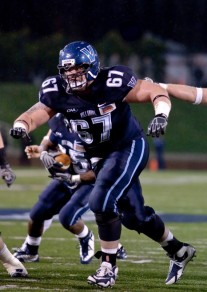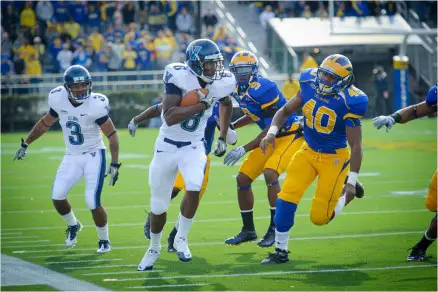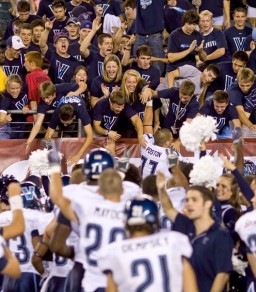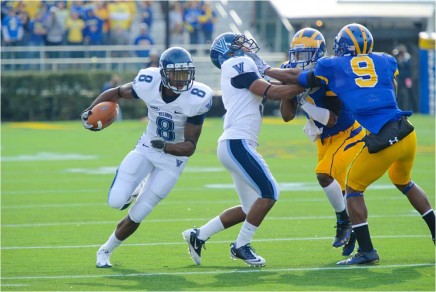A note from FishDuck.com: Today we have a unique treat, this article from a highly successful college coach gives an inside perspective football fans don’t often get to see, the direct insight of football concepts from a coach.
We encourage other coaches that are interested in possibly writing guest columns, providing their unique insight, to please contact us.
For now, here is Brian Flinn of Villanova University, the Recruiting Coordinator and Wide Receivers coach of the Wildcats.
Following our 2010 season at Villanova, I was given the opportunity to speak at a Coaching Clinic focusing on the Double Wing, famously run by Coach Hugh Wyatt (coachwyatt.com). During the previous five seasons, Villanova had used a variation the Single Wing (more commonly referred to as “Wildcat“) formation with great success, similar in name but not by nature.
Like many coaches in all levels of football, we borrowed heavily from the scheme that Coach Wyatt had developed. Unlike many coaches though, we didn’t claim to have “invented” the Wildcat (our mascot being a coincidence and nothing more), the play having become all the rage suddenly in the NFL following Miami’s use of it on Monday Night Football to defeat the vaunted New England Patriots a few years prior.
Shortly thereafter, everybody had to have a “Wildcat” set in their offensive packages, at every level of competition. The ‘Cat was out of the bag.
After reading Tim Layden’s great book on the origins of football schemes, “Blood, Sweat & Chalk,” I decided to give credit where it was due, and always led my presentations by crediting Coach Wyatt; admitting to everyone that, like most coaches, every other idea I’ve ever “had” in football was in fact stolen from someone much smarter than myself.
 On the surface, I have as much business attending a Double Wing Clinic as I would a Mensa meeting. There appears to be very little common ground between the two systems. Double Wing formations often resemble a team picture–with all 11 members of the offense at (or extremely close to) the line of scrimmage.
On the surface, I have as much business attending a Double Wing Clinic as I would a Mensa meeting. There appears to be very little common ground between the two systems. Double Wing formations often resemble a team picture–with all 11 members of the offense at (or extremely close to) the line of scrimmage.
An “All-22” of a Double Wing game often finds many (if not all) of the 22 players on the field in-between the hash marks. In stark contrast, as a spread team operating a Single Wing, our base formations resembled Dean Smith’s 4-corners offense–with players lined up across the width of the field.
At Villanova we never line up under center, and often times won’t even have a running back in the backfield or a tight end in the game. Our two opposing schools of thought between the single and double wing historically have viewed each other as extremists in the wrong direction, making me somewhat of a spread offense ambassador entering the lion’s den to extend an olive branch hoping the arm doesn’t get bitten off in the process.
At the Double Wing Clinic I attended, Coach Wyatt’s presentation preceded mine, and as I began to take notes while he spoke I was stunned to find that regardless of the vast differences in scheme, nearly all of what Coach Wyatt was saying mirrored our offensive philosophy at Villanova.
Quotes from Hugh’s talk (“Be the more physical team” – “Be the better blocking and tackling team” – “Pass the ball when we want to pass it” – “Run the ball in/control the A-Gap“) could all have been taken directly from transcripts of an offensive staff meeting at Villanova, despite the Double Wing being as far from our spread attack as can be imagined.
For both of our offenses, football remains a tough man’s game, a war of attrition that is won by the five big-uglies up front. The differences in philosophy stemmed from who and how those five are supposed to block. What we had in common with Hugh (and all the other Double Wing coaches in the room) was a fanatical belief in running the football first and foremost–we just had different ways of going about it.
Along with the development of the No-Huddle Offense, our transition from a man-blocking scheme to a zone-blocking one was an important paradigm shift for our offense and program. Within the old man-blocking approach we previously utilized, the base plays were Power, Lead Draw and the legendary 80T; helping famous Villanova-alumnus Brian Westbrook run for over 4,200 yards during a record-setting career here on the Main Line before an equally impressive pro stretch.
 Sure, we ran zone blocking on occasion, but rarely, and with little success. As a young GA who had run the zone scheme as a player and coach at Mount Union College, I always lobbied for more of it. Our veteran O-line coach Mark Ferrante would always (and very correctly) counter with the reply: “The zone is an offense – not a play.” It isn’t plausible to run inside or outside zone by itself without utilizing all the complementary runs and play-action passes off it as well.
Sure, we ran zone blocking on occasion, but rarely, and with little success. As a young GA who had run the zone scheme as a player and coach at Mount Union College, I always lobbied for more of it. Our veteran O-line coach Mark Ferrante would always (and very correctly) counter with the reply: “The zone is an offense – not a play.” It isn’t plausible to run inside or outside zone by itself without utilizing all the complementary runs and play-action passes off it as well.
As I learned later (after different coaching stops and research), there is also a need to run constraint plays and drop-back passes that complement the zone scheme. Our search for the consistent design language of the spread inside zone resulted in the identity of the Villanova offense today.
As teams transitioned from 2-back to 1-back offenses, a pressing issue became finding the best way to run the football without a lead blocker. The Lead and Man schemes that were so vital to the West Coast Offense developed by legendary coach Bill Walsh in the 1970’s and 80’s were not nearly as effective with a fullback not on the field.
The great Run and Shoot Offenses of the early 80’s were seen as “Pass-First” outfits with few answers and little concern for the run game. There was a dearth of good one back runs that allowed teams to be in a spread set and still run the ball consistently.
That all changed around the turn of the century with the advent of the Zone-Read and the various other “constraint plays” stemming from the zone. These plays were designed to keep defenses honest versus the run against even the most spread-out of sets. With the addition of the quarterback as a potential ball-carrier and adding a screen runner on the edge on a run/pass option, an offense’s attack that previously was in every run play a man down in the match-ups now instead had a “Plus One.” The Zone-Read was a huge step towards expanding on the effectiveness of the inside zone.
 One of the best resources here at Villanova is our video editing system, coupled with our ability to pirate and track down film of other great spread offenses. Our search for the best way for us to run the ball out of the spread offense began with loading hours of offensive film onto this video system.
One of the best resources here at Villanova is our video editing system, coupled with our ability to pirate and track down film of other great spread offenses. Our search for the best way for us to run the ball out of the spread offense began with loading hours of offensive film onto this video system.
The West Virginia, Utah, Bowling Green, Clemson, Central Michigan and Appalachian State offenses (among many others) were all broken down, analyzed and heavily borrowed/stolen from for Villanova’s gain. If a team had any success running a shotgun spread inside zone in the past decade, there is a good chance that the coaching staff here has their entire season in our database.
After hours of study, we began to see the entirety of the spectrum of spread offenses that teams were developing. On one end were the pass-first groups we had all seen in the early days of the spread – with very little time or concern dedicated to running the football.
However it was the other end of this spectrum that had us far more interested–a run-heavy version of the spread that gave the illusion of a pass on every play, but whose real goal was to run the ball up the defense’s gut (in the A-gap). Affording the ability to line up in historically passing sets yet having the legitimate threat of an inside run (with the zone hand-off) or outside run (with the QB keep, bubble, option pitch or quick pass) quickly grew from intriguing concept to mainstay of the entire playbook.
Film study led to the next logical step: a research trip to the most successful spread-to-run team in the country at the time. While famous for their upset of Michigan, Appalachian State had it rolling long before they shocked the world in the Big House in 2007, a week before Oregon arrived in the Big House and completely dismantled the once-proud and thought to be national title contender Michigan Wolverines once more using the exact same offense.
 The only FCS team to win three consecutive national championships, App State did so with a punishing running game and two-time Walter Payton Award-Winning QB Armanti Edwards at the helm.
The only FCS team to win three consecutive national championships, App State did so with a punishing running game and two-time Walter Payton Award-Winning QB Armanti Edwards at the helm.
App State Head Coach Jerry Moore and his excellent offensive staff are a credit to the coaching profession, their willingness to answer questions and share ideas helped add to our developing scheme and cement many of the core beliefs that would lead to not only full-implementation of the zone-read offense, but eventually Villanova’s first National Championship.
What stood out the most was a cut-up of inside zone runs of 25+ yards. From one season alone, this reel had an unreal 42 clips! Every one of these plays had a common theme: the ball carrier always cut to the front-side A-Gap. Controlling the A-Gap was the most critical element of the spread run game. App State had this as job #1 for the offensive line: control the interior of the box with the five up front – starting with both A-Gaps where the ball most likely is going to get run – and manipulate the numbers and perimeter of the box with WR blocking, QB reads and/or a collection of “constraint” plays we already ran as staples of our offense.
I hadn’t heard of “Constraint Plays” before, but in an article on smartfootball.com, Chris Brown referred to the Bubble/Option/Screen/Quick-Pass game off the zone run as constraints designed to keep a defense honest. This series of complimentary plays were referred to by many different names – “Smoke & Mirrors“, “Lipstick on The Pig” (a Chip Kelly favorite) and “3-Card Monte” among others. However, no name summed up what was trying to be accomplished better than “Constraint”–keeping the defense honest, constraining what they could do/where they could align and trying to manipulate the defensive front into the best run box possible.
The added bonus of constraint plays is they add the appearance of complexity, without adding an additional run scheme. The offense itself is built from the inside-out, with the foundation being the offensive line and their ability to block the zone. In all the different constraints, whether it’s a screen, quarterback run or quick pass, the offensive line is still blocking inside zone.
“It’s all zone to us!” is the offensive line coach’s standard response whenever talking about developing a new constraint. No matter what combination of smoke-and-mirrors are used on the outside, the scenery inside never changes for the five up front. The offensive line blocks inside zone repeatedly until they can do it against any front, stunt, blitz or scheme. The inside zone is not only a play, but the foundation upon which the entire offense is built.
In the wake of meeting with App State’s coaches, the constraint plays developed an appearance of complexity for our offense based on their insight, but at its core the plan remained simple. Plays that majored in before–the bubble screen and stick route being the best examples–were now coupled as run-pass reads with the inside zone, forcing teams to defend the inside and outside all at once.
 The quarterback would not be required to master every play in football, however, he would now be required to make a decision/read on every play run or pass. He did not have to be “right” with every call or decision, but the App State coaches proved that more often than not the ball would be handed off into a pretty good box.
The quarterback would not be required to master every play in football, however, he would now be required to make a decision/read on every play run or pass. He did not have to be “right” with every call or decision, but the App State coaches proved that more often than not the ball would be handed off into a pretty good box.
The bubble screen is the #1 constraint play used in the Villanova offense. When a consistent edge is set outside and there has been success (6 yards or more) with the bubble, teams are forced to cover down, defend the width of the field and give up their numbers advantage in the box. Once that happens, the goal of controlling the A-Gap and line of scrimmage has been accomplished. When defenses chase the constraint plays on the edge of formations, the balance of power in the A-Gap shifts to the offense.
It has been said many times “no one has won a National Championship throwing the bubble screen.” Actually, that statement can be made about any individual scheme by itself. Insert only “quick game”, “Iso” or “sprint-out passing” for “bubble” and the shaky validity of the previous statement remains intact. No offense is built on one scheme or play.
The best offenses are a collection of simple schemes packaged together to complement one another. There is no better example of this packaging than the use of the bubble screen as a constraint play. Spread teams have won many games using the bubble as a primary way to force the hand of opposing defenses: Tilt the front and coverage to stop the bubble constraint at the risk of being gashed in the run game; or ignore eligible receivers in the perimeter and give up 8+ easy yards on a quick screen.
The reads won’t always be right, but they will force the defense in one direction and lead to attacking them in another. The success of App State, Oregon and Villanova (among many others) shows that an effective bubble screen complement off the inside zone can in fact help win a lot of big games and championships.
Among my favorite things about the game of football is the continued learning that seems to unite coaches, players, and fans alike. It allows me to enjoy and learn a great deal from an internet video posted by Josh Schlichter on FishDuck (even though he was probably 5 years old when I started coaching). It keeps me up late on Saturday nights after a game rewinding my DVR trying to figure out who/where Oregon was reading on that big play. It has me writing pages of notes during a talk by Coach Wyatt where he’s describing an offense run with little evolution for the past 50 years.
What unites all life-long learners of football is a desire to run the ball in the A-Gap, up the gut with power. It’s the reason why Hugh Wyatt–despite differences in formations, passing game and a constraint plays–has a philosophy about offense matching those taught in Villanova’s single-wing attack as well.
Football always will be a tough man’s game. As defenses have evolved, running the ball from spread formations has allowed offenses to keep that great tradition alive into the 21st century. It will always evolve, coaches always on the prowl to find better/cooler/more fun ways to accomplish the simple task of attacking the heart of a defense.
Related Articles:
Coach Brian Flinn (Football Analyst) is entering his seventh year as Villanova University’s Wide Receivers Coach and Recruiting Coordinator. A native of Youngstown, OH, Brian Flinn was an All-OAC tight end at Mount Union College before entering the coaching ranks. In addition to Villanova, Coach Flinn has coached at Eastern Illinois University, Drake University, Maryland University, and Mount Union.
Go Villanova Wildcats!


